7.1.3: Nonadjacent Angles
- Page ID
- 38725
\( \newcommand{\vecs}[1]{\overset { \scriptstyle \rightharpoonup} {\mathbf{#1}} } \)
\( \newcommand{\vecd}[1]{\overset{-\!-\!\rightharpoonup}{\vphantom{a}\smash {#1}}} \)
\( \newcommand{\id}{\mathrm{id}}\) \( \newcommand{\Span}{\mathrm{span}}\)
( \newcommand{\kernel}{\mathrm{null}\,}\) \( \newcommand{\range}{\mathrm{range}\,}\)
\( \newcommand{\RealPart}{\mathrm{Re}}\) \( \newcommand{\ImaginaryPart}{\mathrm{Im}}\)
\( \newcommand{\Argument}{\mathrm{Arg}}\) \( \newcommand{\norm}[1]{\| #1 \|}\)
\( \newcommand{\inner}[2]{\langle #1, #2 \rangle}\)
\( \newcommand{\Span}{\mathrm{span}}\)
\( \newcommand{\id}{\mathrm{id}}\)
\( \newcommand{\Span}{\mathrm{span}}\)
\( \newcommand{\kernel}{\mathrm{null}\,}\)
\( \newcommand{\range}{\mathrm{range}\,}\)
\( \newcommand{\RealPart}{\mathrm{Re}}\)
\( \newcommand{\ImaginaryPart}{\mathrm{Im}}\)
\( \newcommand{\Argument}{\mathrm{Arg}}\)
\( \newcommand{\norm}[1]{\| #1 \|}\)
\( \newcommand{\inner}[2]{\langle #1, #2 \rangle}\)
\( \newcommand{\Span}{\mathrm{span}}\) \( \newcommand{\AA}{\unicode[.8,0]{x212B}}\)
\( \newcommand{\vectorA}[1]{\vec{#1}} % arrow\)
\( \newcommand{\vectorAt}[1]{\vec{\text{#1}}} % arrow\)
\( \newcommand{\vectorB}[1]{\overset { \scriptstyle \rightharpoonup} {\mathbf{#1}} } \)
\( \newcommand{\vectorC}[1]{\textbf{#1}} \)
\( \newcommand{\vectorD}[1]{\overrightarrow{#1}} \)
\( \newcommand{\vectorDt}[1]{\overrightarrow{\text{#1}}} \)
\( \newcommand{\vectE}[1]{\overset{-\!-\!\rightharpoonup}{\vphantom{a}\smash{\mathbf {#1}}}} \)
\( \newcommand{\vecs}[1]{\overset { \scriptstyle \rightharpoonup} {\mathbf{#1}} } \)
\( \newcommand{\vecd}[1]{\overset{-\!-\!\rightharpoonup}{\vphantom{a}\smash {#1}}} \)
Lesson
Let's look at angles that are not right next to one another.
Exercise \(\PageIndex{1}\): Finding Related Statements
Given \(a\) and \(b\) are numbers, and \(a+b=180\), which statements also must be true?
\(a=180-b\qquad a-180=b\qquad 360=2a+2b\qquad a=90\text{ and }b=90\)
Exercise \(\PageIndex{2}\): Polygon Angles
Use any useful tools in the geometry toolkit to identify any pairs of angles in these figures that are complementary or supplementary.

Exercise \(\PageIndex{3}\): Vertical Angles
Use a straightedge to draw two intersecting lines. Use a protractor to measure all four angles whose vertex is located at the intersection.
Compare your drawing and measurements to the people in your group. Make a conjecture about the relationships between angle measures at an intersection.
Exercise \(\PageIndex{4}\): Row Game: Angles
Find the measure of the angles in one column. Your partner will work on the other column. Check in with your partner after you finish each row. Your answers in each row should be the same. If your answers aren’t the same, work together to find the error and correct it.
column A
\(P\) is on line \(m\). Find the value of \(a\).

Find the value of \(a\).
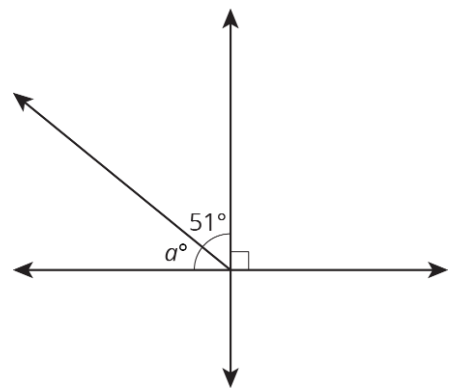
column B
Find the value of \(b\).
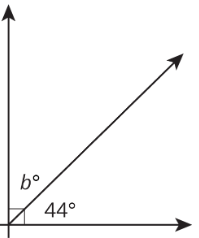
In right triangle \(LMN\), angles \(L\) and \(M\) are complementary. Find the measure of angle \(L\).
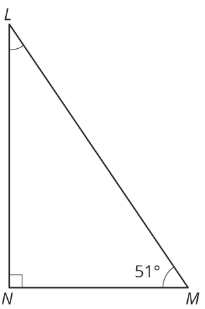
column A
Angle \(C\) and angle \(E\) are supplementary. Find the measure of angle \(E\).

Find the value of \(c\).

Two angles are complementary. One angle measures 37 degrees. Find the measure of the other angle.
column B
\(X\) is on line \(WY\). Find the value of \(b\).

\(B\) is on line \(FW\). Find the measure of angle \(CBW\).
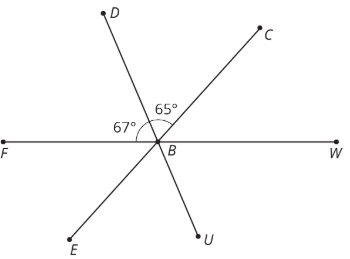
Two angles are supplementary. One angle measures 127 degrees. Find the measure of the other angle.
Summary
When two lines cross, they form two pairs of vertical angles. Vertical angles are across the intersection point from each other.

Vertical angles always have equal measure. We can see this because they are always supplementary with the same angle. For example:

This is always true!

\(a+b=180\) so \(a=180-b\).
\(c+b=180\) so \(c=180-b\).
That means \(a=c\).
Glossary Entries
Definition: Adjacent Angles
Adjacent angles share a side and a vertex.
In this diagram, angle \(ABC\) is adjacent to angle \(DBC\).
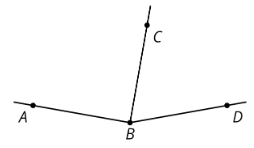
Definition: Complementary
Complementary angles have measures that add up to 90 degrees.
For example, a \(15^{\circ}\) angle and a \(75^{\circ}\) angle are complementary.
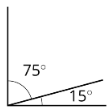

Definition: Right Angle
A right angle is half of a straight angle. It measures 90 degrees.
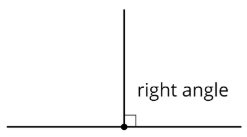
Definition: Straight Angle
A straight angle is an angle that forms a straight line. It measures 180 degrees.

Definition: Supplementary
Supplementary angles have measures that add up to 180 degrees.
For example, a \(15^{\circ}\) angle and a \(165^{\circ}\) angle are supplementary.


Definition: Vertical Angles
Vertical angles are opposite angles that share the same vertex. They are formed by a pair of intersecting lines. Their angle measures are equal.
For example, angles \(AEC\) and \(DEB\) are vertical angles. If angle \(AEC\) measures \(120^{\circ}\), then angle \(DEB\) must also measure \(120^{\circ}\).
Angles \(AED\) and \(BEC\) are another pair of vertical angles.
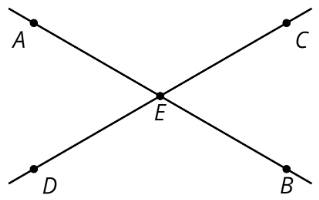
Practice
Exercise \(\PageIndex{5}\)
Two lines intersect. Find the value of \(b\) and \(c\).

Exercise \(\PageIndex{6}\)
In this figure, angles \(R\) and \(S\) are complementary. Find the measure of angle \(S\).

Exercise \(\PageIndex{7}\)
If two angles are both vertical and supplementary, can we determine the angles? Is it possible to be both vertical and complementary? If so, can you determine the angles? Explain how you know.
Exercise \(\PageIndex{8}\)
Match each expression in the first list with an equivalent expression from the second list.
- \(5(x+1)-2x+11\)
- \(2x+2+x+5\)
- \(\frac{-3}{8}x-9+\frac{5}{8}x+1\)
- \(2.06x-5.53+4.98-9.02\)
- \(99x+44\)
- \(\frac{1}{4}x-8\)
- \(\frac{1}{2}(6x+14)\)
- \(11(9x+4)\)
- \(3x+16\)
- \(2.06x+(-5.53)+4.98+(-9.02)\)
(From Unit 6.4.5)
Exercise \(\PageIndex{9}\)
Factor each expression.
- \(15a-13a\)
- \(-6x-18y\)
- \(36abc+54ad\)
(From Unit 6.4.2)
Exercise \(\PageIndex{10}\)
The directors of a dance show expect many students to participate but don’t yet know how many students will come. The directors need 7 students to work on the technical crew. The rest of the students work on dance routines in groups of 9. For the show to work, they need at least 6 full groups working on dance routines.
- Write and solve an inequality to represent this situation, and graph the solution on a number line.
- Write a sentence to the directors about the number of students they need.
(From Unit 6.3.5)
Exercise \(\PageIndex{11}\)
A small dog gets fed \(\frac{3}{4}\) cup of dog food twice a day. Using \(d\) for the number of days and \(f\) for the amount of food in cups, write an equation relating the variables. Use the equation to find how many days a large bag of dog food will last if it contains 210 cups of food.
(From Unit 2.2.2)


